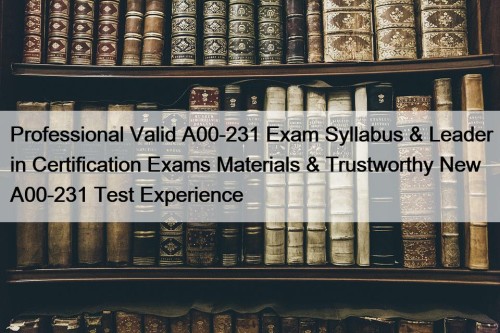Most Popular
 Professional Valid A00-231 Exam Syllabus & Leader in Certification Exams Materials & Trustworthy New A00-231 Test Experience
Professional Valid A00-231 Exam Syllabus & Leader in Certification Exams Materials & Trustworthy New A00-231 Test Experience
DOWNLOAD the newest Pass4sures A00-231 PDF dumps from Cloud Storage ...
 Valid Exam AZ-800 Preparation | AZ-800 Exam Practice
Valid Exam AZ-800 Preparation | AZ-800 Exam Practice
2025 Latest Lead1Pass AZ-800 PDF Dumps and AZ-800 Exam Engine ...
 D-PST-MN-A-24 Test Dumps.zip, Latest D-PST-MN-A-24 Test Questions
D-PST-MN-A-24 Test Dumps.zip, Latest D-PST-MN-A-24 Test Questions
2025 Latest Pass4cram D-PST-MN-A-24 PDF Dumps and D-PST-MN-A-24 Exam Engine ...



Salesforce Agentforce-Specialist PDF Dumps Format - Easy To Use

You have seen Lead2Passed's Salesforce Agentforce-Specialist Exam Training materials, it is time to make a choice. You can choose other products, but you have to know that Lead2Passed can bring you infinite interests. Only Lead2Passed can guarantee you 100% success. Lead2Passed allows you to have a bright future. And allows you to work in the field of information technology with high efficiency.
Salesforce Agentforce-Specialist Exam Syllabus Topics:
| Topic | Details |
|---|---|
| Topic 1 |
|
| Topic 2 |
|
| Topic 3 |
|
| Topic 4 |
|
| Topic 5 |
|
>> Agentforce-Specialist Test Objectives Pdf <<
Salesforce Agentforce-Specialist Exam Success | Agentforce-Specialist Reliable Test Topics
You can first download Lead2Passed's free exercises and answers about Salesforce certification Agentforce-Specialist exam as a try, then you will feel that Lead2Passed give you a reassurance for passing the exam. If you choose Lead2Passed to provide you with the pertinence training, you can easily pass the Salesforce Certification Agentforce-Specialist Exam.
Salesforce Certified Agentforce Specialist Sample Questions (Q160-Q165):
NEW QUESTION # 160
Universal Containers wants to use an external large language model (LLM) in Prompt Builder.
What should An Agentforce recommend?
- A. Use Flow and External Services to bring data from an external LLM.
- B. Use Apex to connect to an external LLM and ground the prompt.
- C. Use BYO-LLM functionality in Einstein Studio.
Answer: C
Explanation:
Bring Your Own Large Language Model (BYO-LLM)functionality inEinstein Studioallows organizations to integrate and use external large language models (LLMs) within the Salesforce ecosystem.Universal Containerscan leverage this feature to connect and ground prompts with external LLMs, allowing for custom AI model use cases and seamless integration with Salesforce data.
* Option Bis the correct choice asEinstein Studioprovides a built-in feature to work with external models.
* Option Asuggests using Apex, butBYO-LLMfunctionality offers a more streamlined solution.
* Option Cfocuses onFlow and External Services, which is more about data integration and isn't ideal for working with LLMs.
References:
Salesforce Einstein Studio BYO-LLM Documentation:https://help.salesforce.com/s/articleView?id=sf.
einstein_studio_llm.htm
NEW QUESTION # 161
Universal Containers wants to allow its service agents to query the current fulfillment status of an order with natural language. There is an existing auto launched flow to query the information from Oracle ERP, which is the system of record for the order fulfillment process.
How should An Agentforce apply the power of conversational AI to this use case?
- A. Create a Flex prompt template in Prompt Builder.
- B. Create a custom copilot action which calls a flow.
- C. Configure the Integration Flow Standard Action in Einstein Copilot.
Answer: B
Explanation:
To enableUniversal Containersservice agents to query the current fulfillment status of an order using natural language and leverage an existing auto-launched flow that queries Oracle ERP, the best solution is tocreate a custom copilot action that calls the flow. This action will allowEinstein Copilotto interact with the flow and retrieve the required order fulfillment information seamlessly. Custom copilot actions can be tailored to call various backend systems or flows in response to user requests.
* Option Bis correct because it enables integration betweenEinstein Copilotand the flow that connects to Oracle ERP.
* Option A(Flex prompt template) is more suited for static responses and not for invoking flows.
* Option C(Integration Flow Standard Action) is not directly related to creating a specific copilot action for this use case.
References:
* Salesforce Einstein Copilot Actions:https://help.salesforce.com/s/articleView?
id=einstein_copilot_actions.htm
NEW QUESTION # 162
An Agentforce at Universal Containers is trying to set up a new Field Generation prompt template. They take the following steps.
1. Create a new Field Generation prompt template.
2. Choose Case as the object type.
3. Select the custom field AI_Analysis_c as the target field.
After creating the prompt template, theAgentforce Specialistsaves, tests, and activates it. Howsoever, when they go to a case record, the AI Analysis field does not show the (Sparkle) icon on the Edit pencil. When theAgentforce Specialistwas editing the field, it was behaving as a normal field.
Which critical step did theAgentforce Specialistmiss?
- A. They forgot that the Case Object is not supported for Add generation as Feinstein Service Replies should be used instead.
- B. They forgot to edit the Lightning page layout and associate the field to a prompt template
- C. They forgot to reactivate the Lightning page layout for the Case object after activating their Field Generation prompt template.
Answer: B
Explanation:
For Field Generation prompt templates to display the Sparkle icon (indicating AI-generated content), the target field must be explicitly associated with the prompt template on the Lightning page layout. Even if the prompt template is activated, failing to add the field to the page layout and link it to the template will result in the field behaving as a standard field. Salesforce documentationemphasizes that page layout configuration is mandatory to enable AI-driven field interactions.
* Reactivating the layout (A) is unnecessary unless the layout itself was modified after activation.
* Case objects are supported for Field Generation (B is incorrect).
NEW QUESTION # 163
How does the AI Retriever function within Data Cloud?
- A. It performs contextual searches over an indexed repository to quickly fetch the most relevant documents, enabling grounding AI responses with trustworthy, verifiable information.
- B. It monitors and aggregates data quality metrics across various data pipelines to ensure only high- integrity data is used for strategic decision-making.
- C. It automatically extracts and reformats raw data from diverse sources into standardized datasets for use in historical trend analysis and forecasting.
Answer: A
Explanation:
Comprehensive and Detailed In-Depth Explanation:The AI Retriever is a key component in Salesforce Data Cloud, designed to support AI-driven processes like Agentforce by retrieving relevant data. Let's evaluate each option based on its documented functionality.
* Option A: It performs contextual searches over an indexed repository to quickly fetch the most relevant documents, enabling grounding AI responses with trustworthy, verifiable information.
The AI Retriever in Data Cloud uses vector-based search technology to query an indexed repository (e.
g., documents, records, or ingested data) and retrieve the most relevant results based on context. It employs embeddings to match user queries or prompts with stored data, ensuring AI responses (e.g., in Agentforce prompt templates) are grounded in accurate, verifiable information from Data Cloud. This enhances trustworthiness by linking outputs to source data, making it the primary function of the AI Retriever. This aligns with Salesforce documentation and is the correct answer.
* Option B: It monitors and aggregates data quality metrics across various data pipelines to ensure only high-integrity data is used for strategic decision-making.Data quality monitoring is handled by other Data Cloud features, such as Data Quality Analysis or ingestion validation tools, not the AI Retriever. The Retriever's role is retrieval, not quality assessment or pipeline management. This option is incorrect as it misattributes functionality unrelated to the AI Retriever.
* Option C: It automatically extracts and reformats raw data from diverse sources into standardized datasets for use in historical trend analysis and forecasting.Data extraction and standardization are part of Data Cloud's ingestion and harmonization processes (e.g., via Data Streams or Data Lake), not the AI Retriever's function. The Retriever works with already-indexed data to fetch results, not to process or reformat raw data. This option is incorrect.
Why Option A is Correct:The AI Retriever's core purpose is to perform contextual searches over indexed data, enabling AI grounding with reliable information. This is critical for Agentforce agents to provide accurate responses, as outlined in Data Cloud and Agentforce documentation.
References:
* Salesforce Data Cloud Documentation: AI Retriever- Describes its role in contextual searches for grounding.
* Trailhead: Data Cloud for Agentforce- Explains how the AI Retriever fetches relevant data for AI responses.
* Salesforce Help: Grounding with Data Cloud- Confirms the Retriever's search functionality over indexed repositories.
NEW QUESTION # 164
What is a valid use case for Data Cloud retrievers?
- A. Modifying and updating data within the source systems connected to Data Cloud.
- B. Returning relevant data from the vector database to augment a prompt.
- C. Grounding data from external websites to augment a prompt with RAG.
Answer: B
Explanation:
Comprehensive and Detailed In-Depth Explanation:Salesforce Data Cloud integrates with Agentforce to provide real-time, unified data access for AI-driven applications.Data Cloud retrieversare specialized components that fetch relevant data from Data Cloud's vector database-a storage system optimized for semantic search and retrieval-to enhance agent responses or actions. A valid use case, as described in Option A, is using these retrievers to return pertinent data (e.g., customer purchase history, support tickets) from the vector database to augment a prompt. This process, often part of Retrieval-Augmented Generation (RAG), allows the LLM to generate more accurate, context-aware responses by grounding its output in structured, searchable data stored in Data Cloud.
* Option B: Grounding data from external websites is not a primary function of Data Cloud retrievers.
While RAG can incorporate external data, Data Cloud retrievers specifically work with data within Salesforce's ecosystem (e.g., the vector database or harmonized data lakes), not arbitrary external websites. This makes B incorrect.
* Option C: Data Cloud retrievers are read-only mechanisms designed for data retrieval, not for modifying or updating source systems. Updates to source systems are handled by other Salesforce tools (e.g., Flows or Apex), not retrievers.
Option A is correct because it aligns with the core purpose of Data Cloud retrievers: enhancing prompts with relevant, vectorized data from within Salesforce Data Cloud.
References:
* Salesforce Data Cloud Documentation: "Data Cloud for Agentforce" (Salesforce Help:https://help.
salesforce.com/s/articleView?id=sf.data_cloud_agentforce.htm&type=5)
* Trailhead: "Data Cloud Basics" module (https://trailhead.salesforce.com/content/learn/modules/data- cloud-basics)
NEW QUESTION # 165
......
Our Agentforce-Specialist exam braindumps are famous for the advantage of high-efficiency and high-effective. And it is proved by the high pass rate. The 99% pass rate is a very proud result for us. If you join, you will become one of the 99% to pass the Agentforce-Specialist Exam and achieve the certification. Believe in yourself, you can do it! Buy Agentforce-Specialist study guide now and we will help you. Believe it won't be long before, you are the one who succeeded!
Agentforce-Specialist Exam Success: https://www.lead2passed.com/Salesforce/Agentforce-Specialist-practice-exam-dumps.html
- Agentforce-Specialist Exam Objectives 📁 New Agentforce-Specialist Exam Testking ✒ Agentforce-Specialist Official Cert Guide 🌝 Search for ▷ Agentforce-Specialist ◁ and easily obtain a free download on ➡ www.examcollectionpass.com ️⬅️ 🔤Reliable Agentforce-Specialist Test Book
- Pdfvce Salesforce Agentforce-Specialist Questions PDF Format 👲 Simply search for ➥ Agentforce-Specialist 🡄 for free download on ⏩ www.pdfvce.com ⏪ ✊Agentforce-Specialist Reliable Test Cost
- Free PDF Quiz Fantastic Salesforce - Agentforce-Specialist Test Objectives Pdf 😰 Simply search for ➤ Agentforce-Specialist ⮘ for free download on ➤ www.dumps4pdf.com ⮘ ➡Agentforce-Specialist Latest Dumps Free
- Pass Guaranteed Quiz 2025 Unparalleled Salesforce Agentforce-Specialist: Salesforce Certified Agentforce Specialist Test Objectives Pdf 🌝 Search for 《 Agentforce-Specialist 》 on ➠ www.pdfvce.com 🠰 immediately to obtain a free download 🏈Valid Agentforce-Specialist Test Topics
- Salesforce Agentforce-Specialist premium VCE file, real Agentforce-Specialist questions and answers 🧫 Go to website 【 www.prep4away.com 】 open and search for ☀ Agentforce-Specialist ️☀️ to download for free 🥊Agentforce-Specialist Official Cert Guide
- Excellent Agentforce-Specialist Prep Guide is Best Study Braindumps for Agentforce-Specialist exam 🔼 Search for ⮆ Agentforce-Specialist ⮄ on 「 www.pdfvce.com 」 immediately to obtain a free download 👡New Agentforce-Specialist Test Pdf
- Exam Agentforce-Specialist Materials 🟩 New Agentforce-Specialist Exam Testking 📁 Agentforce-Specialist Lead2pass Review 🥫 Go to website “ www.real4dumps.com ” open and search for ( Agentforce-Specialist ) to download for free 🏖Agentforce-Specialist Latest Dumps Free
- New Agentforce-Specialist Study Guide 👌 Reliable Agentforce-Specialist Test Book 👦 Agentforce-Specialist New Braindumps 🍆 Download ➽ Agentforce-Specialist 🢪 for free by simply entering 【 www.pdfvce.com 】 website 🎸Agentforce-Specialist Practical Information
- New Agentforce-Specialist Test Pdf 🤵 Exam Agentforce-Specialist Materials 💞 Latest Agentforce-Specialist Braindumps Free 😅 Download “ Agentforce-Specialist ” for free by simply searching on ▛ www.vceengine.com ▟ 🍂Reliable Agentforce-Specialist Test Book
- Free PDF Salesforce - Accurate Agentforce-Specialist Test Objectives Pdf 🚥 The page for free download of ➠ Agentforce-Specialist 🠰 on ➥ www.pdfvce.com 🡄 will open immediately 💽New Agentforce-Specialist Exam Testking
- Agentforce-Specialist Latest Dumps Free 🚨 Agentforce-Specialist Exam Objectives 📏 Exam Agentforce-Specialist Materials 👨 Search for ▷ Agentforce-Specialist ◁ and easily obtain a free download on 「 www.pass4leader.com 」 👴New Agentforce-Specialist Test Pdf
- Agentforce-Specialist Exam Questions
- ncr360.com jmtunlockteam.net mkasem.com 15000n-03.duckart.pro mppshop.net skillsharp.co.in zybls.com korodhsoaqoon.com 10000n-06.duckart.pro projectsoftskills.com
Tags: Agentforce-Specialist Test Objectives Pdf, Agentforce-Specialist Exam Success, Agentforce-Specialist Reliable Test Topics, Reliable Agentforce-Specialist Test Duration, Agentforce-Specialist Reliable Exam Review